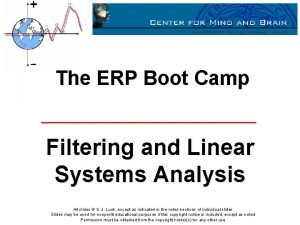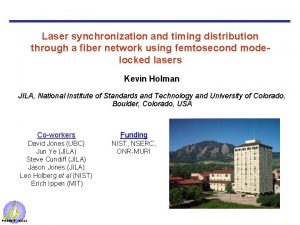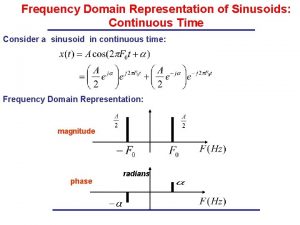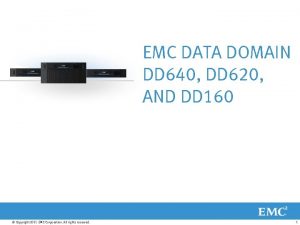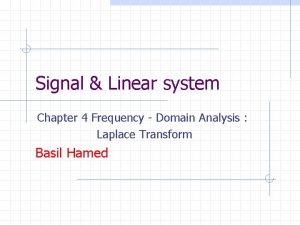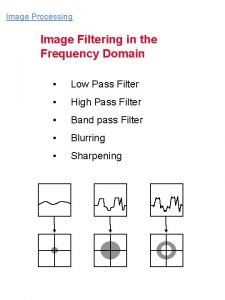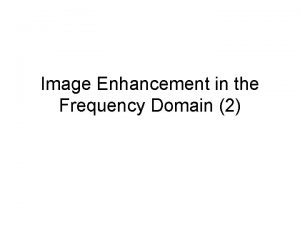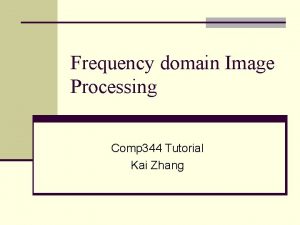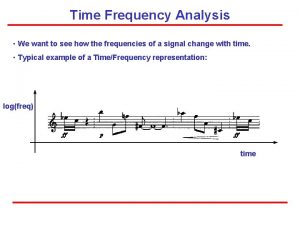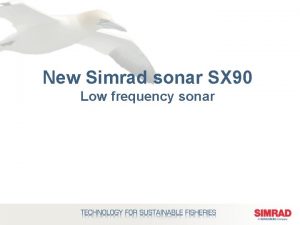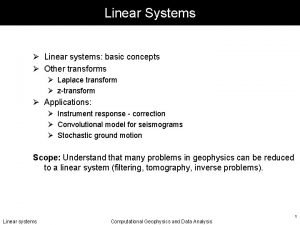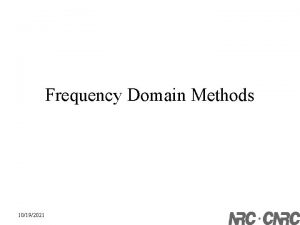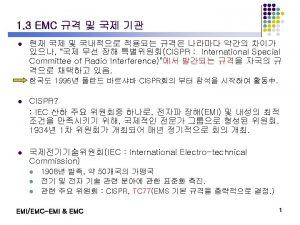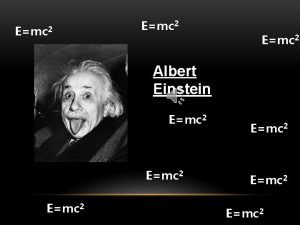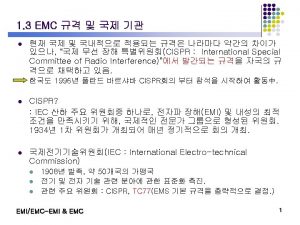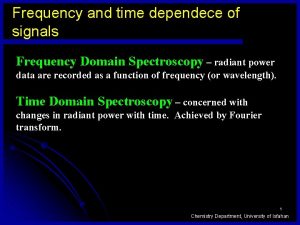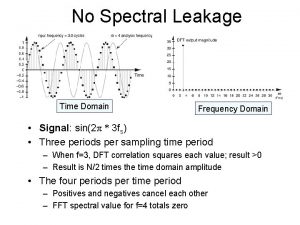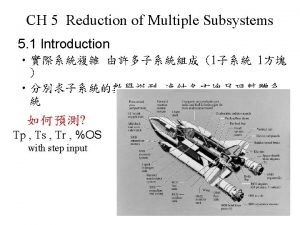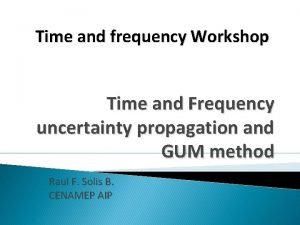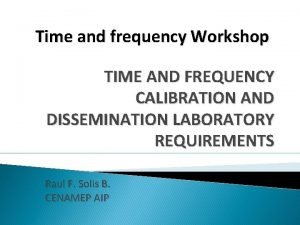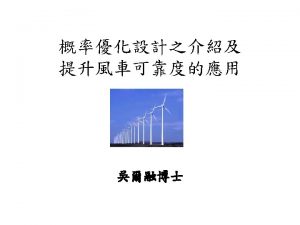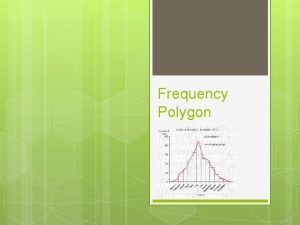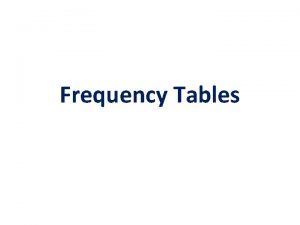Fundamentals of EMC Time Domain vs Frequency Domain





































- Slides: 37

Fundamentals of EMC Time Domain vs. Frequency Domain John Mc. Closkey NASA/GSFC Chief EMC Engineer Code 565 Building 23, room E 203 301 -286 -5498 John. C. Mc. Closkey@nasa. gov 1

Full Demo/Tutorial Video of full demonstration/tutorial on NESC Academy website n “Effects of Rise/Fall Times on Signal Spectra” n Link on GSFC EMC Working Group XSPACES SITE: • https: //xspaces. gsfc. nasa. gov/display/EMCWG/Home 2

Purpose of Demo/Tutorial l Demonstrate the relationship between time domain and frequency domain representations of signals l In particular, demonstrate the relationship between rise/fall times of digital clock-type signals and their associated spectra l Fast rise/fall times can produce significant high frequency content out to 1000 th harmonic and beyond n Common cause of radiated emissions that can interfere with on-board receivers n Can be reduced by limiting rise/fall times 3

Topics l Sinusoid: Time Domain vs. Frequency Domain l Fourier series expansions of: n Square wave n Rectangular pulse train n Trapezoidal waveform l Comparison to measured results for these waveforms l Observations 4

Demo 4: Time Domain vs. Frequency Domain 5

Demo 4: Time Domain vs. Frequency Domain (cont. ) l Equipment n Tektronix MDO 3104 oscilloscope (built-in signal generator) n 2 RG-58 coax cables n T connector n BNC-N adaptor l Setup n AFG: 1 MHz sine, square, pulse with 300 ns width (30% duty cycle) 6

Demo 4: Time Domain vs. Frequency Domain (cont. ) 7

Demo 4: Time Domain vs. Frequency Domain (cont. ) 8

Demo 4: Time Domain vs. Frequency Domain (cont. ) 9

Sinusoid: Time Domain vs. Frequency Domain TIME DOMAIN FREQUENCY DOMAIN Amplitude A f Frequency 10

Fourier Series Expansion of Signal Waveforms l Recommended reading for an in-depth look at Fourier series expansions of signal waveforms: n Clayton Paul, “Introduction to Electromagnetic Compatibility, ” sections 3. 1 and 3. 2 11

Fourier Series Expansion of Square Wave Odd harmonics only 12

Fourier Series Expansion of Rectangular Pulse Train Even harmonics included sin(x)/x (next slide) NOTE: For 50% duty cycle (τ/T = 0. 5), this equation reduces to that for the square wave on the previous slide. 13

Response and Envelope of sin(x)/x Response of |sin(x)/x|: 0 for x = nπ 1/x for x = (n+1)π/2 Envelope of |sin(x)/x|: 1 for x < 1 1/x for x > 1 Lines meet at x = 1 14

Envelope of Rectangular Pulse Train Spectrum DC offset Low frequency “plateau” Harmonic response 0 d. B/decade -20 d. B/ dec ade etc… f 1 PULSE WIDTH f 2 f 3 f 4 f 5 f 15

Fourier Series Expansion of Trapezoidal Waveform A τr τ T τf NOTE: τr and τf are generally measured between 10% and 90% of the minimum and maximum values of the waveform. Assume τr = τf : Additional sin(x)/x term due to rise/fall time 16

Envelope of Trapezoidal Waveform Spectrum DC offset Low frequency “plateau” 0 d. B/decade Harmonic response (pulse width) -20 d. B/ Harmonic response (rise/fall time) dec ade -4 0 d. B /d e ca de etc… f 1 PULSE WIDTH f 2 f 3 f 4 RISE/FALL TIME f 5 f 17

Envelope of Trapezoidal Waveform Spectrum Slower rise/fall times provide additional roll-off of higher order harmonics 0 d. B/decade -20 d. B/ dec ade -4 0 d. B /d e ca de f PULSE WIDTH RISE/FALL TIME 18

Time Domain vs. Frequency Domain Test Setup WAVETEK 801 pulse generator TEKTRONIX RSA 5103 A spectrum analyzer (50 Ω input) TEKTRONIX DPO 7054 oscilloscope (1 MΩ input) 19

Applied Waveform A τr τ T τf A=1 V T = 200 µs (f 0 = 5 k. Hz) τ, τr , & τf varied as indicated on following slides 20

τ = 100 µs (τ/T = 50%); τr = τf = 40 ns 2 A(τ/T) = 1 V = 120 d. BµV 21

τ = 100 µs (τ/T = 50%); τr = τf = 360 ns 2 A(τ/T) = 1 V = 120 d. BµV 22


τ = 100 µs (τ/T = 50%); τr = τf = 10 µs 2 A(τ/T) = 1 V = 120 d. BµV 24

τ = 80 µs (τ/T = 40%); τr = τf = 40 ns 2 A(τ/T) = 0. 8 V = 118 d. BµV 25

τ = 80 µs (τ/T = 40%); τr = τf = 360 ns 2 A(τ/T) = 0. 8 V = 118 d. BµV 26



τ = 10 µs (τ/T = 5%); τr = τf = 40 ns 2 A(τ/T) = 0. 1 V = 100 d. BµV 29

τ = 10 µs (τ/T = 5%); τr = τf = 350 ns 2 A(τ/T) = 0. 1 V = 100 d. BµV 30



τ = 2 µs (τ/T = 1%); τr = τf = 160 ns 2 A(τ/T) = 0. 02 V = 86 d. BµV 33

τ = 2 µs (τ/T = 1%); τr = τf = 400 ns 2 A(τ/T) = 0. 02 V = 86 d. BµV 34

τ = 100 ns (τ/T = 0. 05%); τr = τf = 8 ns 2 A(τ/T) = 0. 001 V = 60 d. BµV 35

Observations (1 of 2) l Measured spectra show good agreement with expected values n “ 3 -line” envelope provides simple, accurate, and powerful analytical tool for correlating signal spectra to trapezoidal waveforms l Even harmonics n Reduced, but not zero, amplitude for 50% duty cycle n Varying amplitude for other than 50% duty cycle n Must be considered as potentially significant contributors to spectrum l Low frequency plateau scales with duty cycle n Spectrum for low duty cycle waveforms gives artificial indication of low amplitude n First “knee” frequency may be quite high, producing relatively flat spectrum for many harmonics (100 s or 1000 s in these examples) n Low duty cycle waveforms should be observed in time domain (oscilloscope) as well as frequency domain (spectrum analyzer) 36

Observations (2 of 2) l Signal spectra significantly more determined by rise/fall times than by fundamental frequency of waveform l Uncontrolled rise/fall times can produce significant frequency content out to 1000 th harmonic and beyond n Common cause of radiated emissions n 5 MHz clock can easily produce harmonics out to 5 GHz and beyond n Potential interference to S-band receiver (~2 GHz), GPS (~1. 5 GHz), etc. l Controlling rise/fall times can significantly limit high frequency content at source LIMIT THOSE RISE/FALL TIMES!!! 37
 Frequency domain to time domain
Frequency domain to time domain Z domain to frequency domain
Z domain to frequency domain Z transform time reversal
Z transform time reversal The z transform of np
The z transform of np High pass and low pass filters
High pass and low pass filters Laser synchronization
Laser synchronization Time frequency domain
Time frequency domain Data domain dd160
Data domain dd160 What is joint relative frequency
What is joint relative frequency How to calculate relative frequency
How to calculate relative frequency Power of sine wave
Power of sine wave How is linear frequency related to angular frequency?
How is linear frequency related to angular frequency? Relative frequency bar chart
Relative frequency bar chart Marginal frequency distribution
Marginal frequency distribution Two way conditional frequency table for gender
Two way conditional frequency table for gender For minutes. start.
For minutes. start. Laplace frequency domain
Laplace frequency domain Multiplication property of fourier transform
Multiplication property of fourier transform Circular convolution definition
Circular convolution definition Band pass filter in image processing
Band pass filter in image processing Frequency domain image
Frequency domain image Image processing frequency domain
Image processing frequency domain Work study diagram
Work study diagram Fitness components
Fitness components Time-frequency
Time-frequency Time-frequency
Time-frequency Grammar cl games
Grammar cl games Introduction to functions (review game)
Introduction to functions (review game) Domain specific vs domain general
Domain specific vs domain general Domain specific software engineering
Domain specific software engineering Problem domain vs knowledge domain
Problem domain vs knowledge domain S domain to z domain
S domain to z domain The designer expresses the ideas in terms related to the
The designer expresses the ideas in terms related to the Emc of teamhealth
Emc of teamhealth Secure remote service
Secure remote service Emc 600 alh
Emc 600 alh Emc content management
Emc content management Emc standard
Emc standard




